The Significance of Privacy in the Workplace: An Evaluation
VerifiedAdded on 2022/01/20
|9
|3109
|145
Essay
AI Summary
This essay critically evaluates the significance of workplace privacy in modern organizations. It explores the evolving dynamics of employee-employer relationships in the digital age, where monitoring and surveillance are increasingly prevalent. The essay examines the challenges associated with workplace privacy, differentiating between information and work environment privacy, and analyzes the impacts of both lack of privacy and excessive privacy on employees and employers. It highlights the importance of balancing employee rights with employer needs, considering issues such as employee monitoring, data collection, and the potential for privacy violations. The essay discusses the negative effects of excessive monitoring on employee morale, trust, and productivity, while also acknowledging the potential negative impacts of a lack of monitoring on organizational performance. The study concludes by emphasizing the need for organizations to establish clear privacy policies and practices that protect employee rights while still allowing for effective management and operational efficiency.
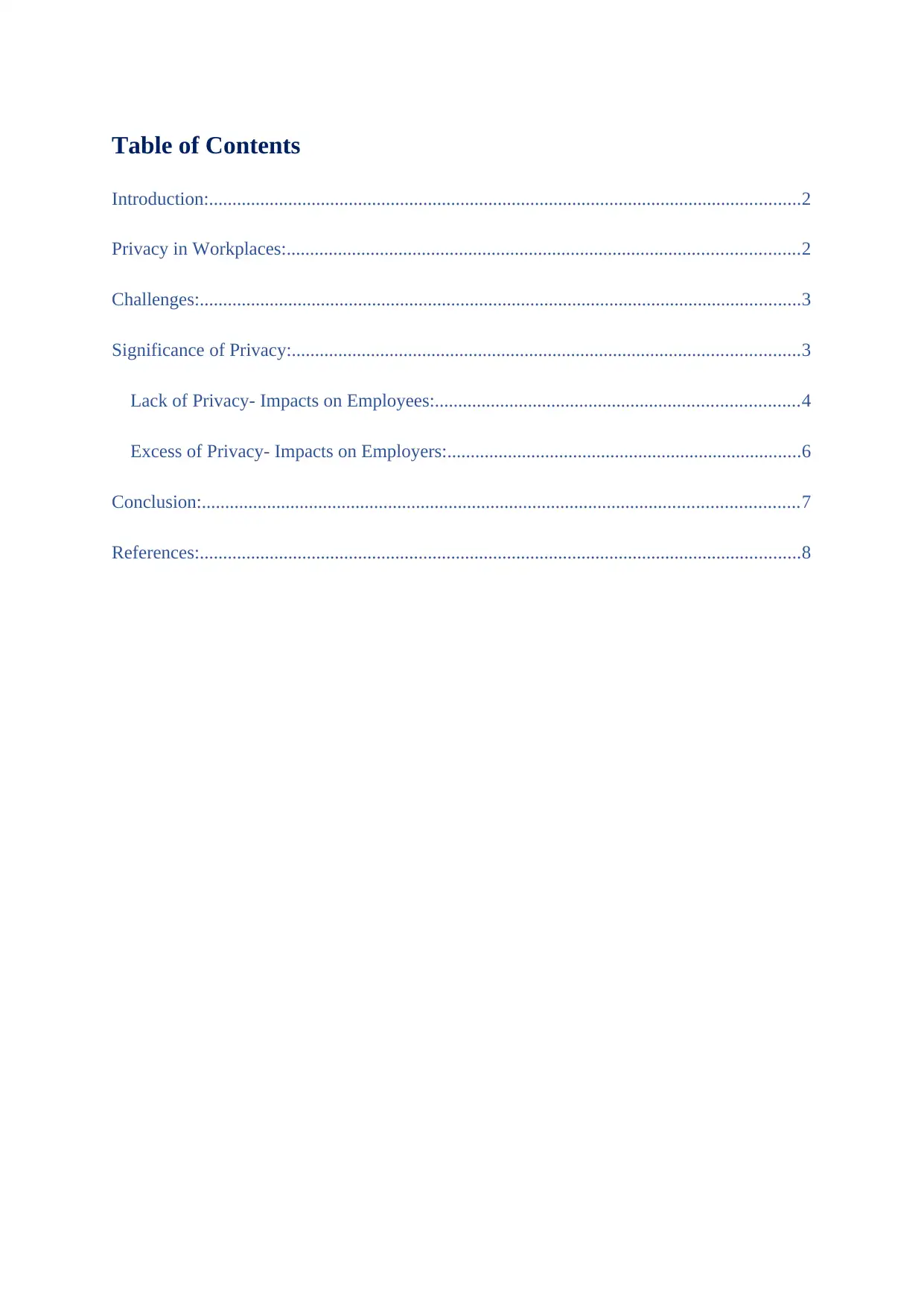
Table of Contents
Introduction:...............................................................................................................................2
Privacy in Workplaces:..............................................................................................................2
Challenges:.................................................................................................................................3
Significance of Privacy:.............................................................................................................3
Lack of Privacy- Impacts on Employees:..............................................................................4
Excess of Privacy- Impacts on Employers:............................................................................6
Conclusion:................................................................................................................................7
References:.................................................................................................................................8
Introduction:...............................................................................................................................2
Privacy in Workplaces:..............................................................................................................2
Challenges:.................................................................................................................................3
Significance of Privacy:.............................................................................................................3
Lack of Privacy- Impacts on Employees:..............................................................................4
Excess of Privacy- Impacts on Employers:............................................................................6
Conclusion:................................................................................................................................7
References:.................................................................................................................................8
Paraphrase This Document
Need a fresh take? Get an instant paraphrase of this document with our AI Paraphraser
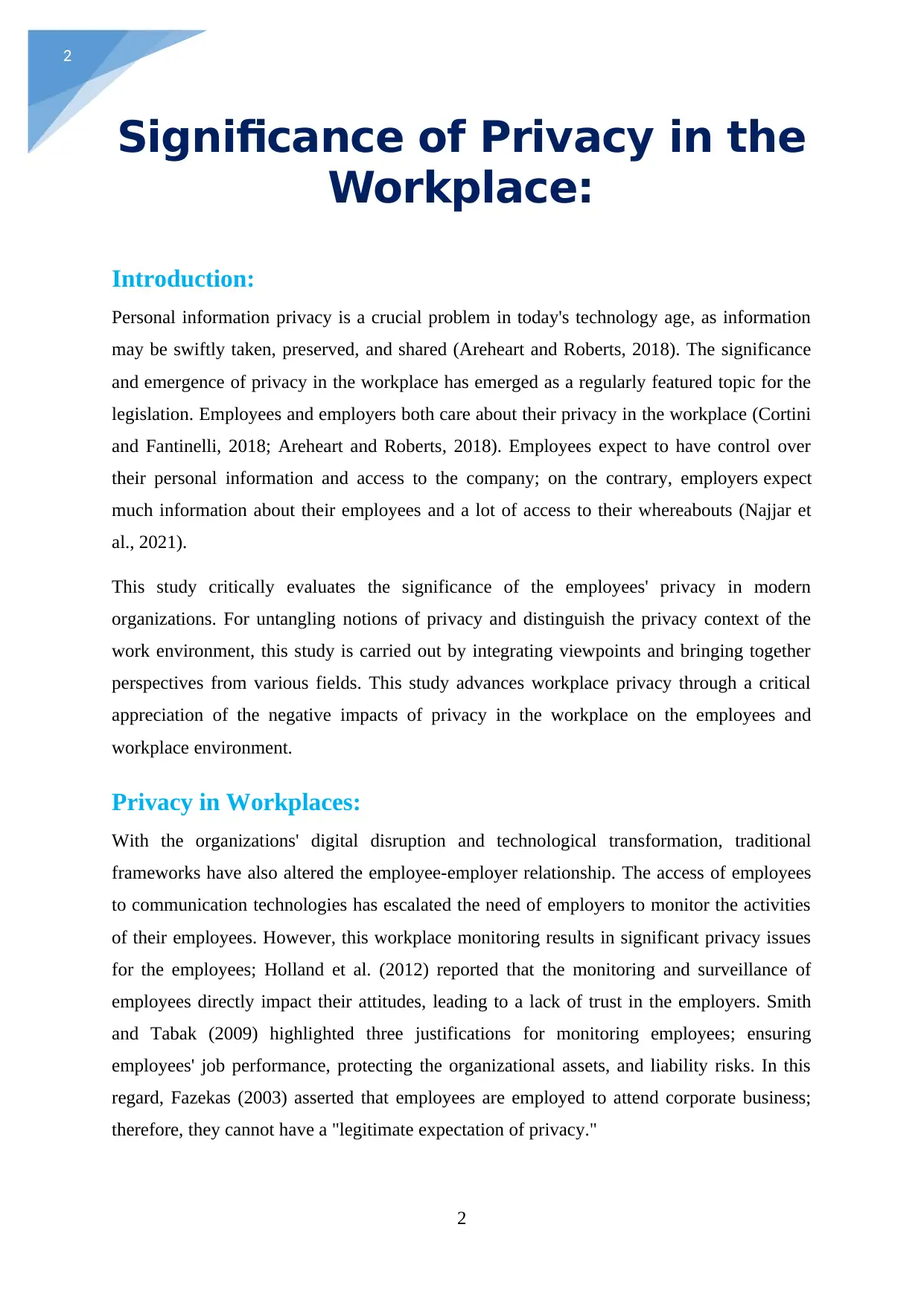
2
Significance of Privacy in the
Workplace:
Introduction:
Personal information privacy is a crucial problem in today's technology age, as information
may be swiftly taken, preserved, and shared (Areheart and Roberts, 2018). The significance
and emergence of privacy in the workplace has emerged as a regularly featured topic for the
legislation. Employees and employers both care about their privacy in the workplace (Cortini
and Fantinelli, 2018; Areheart and Roberts, 2018). Employees expect to have control over
their personal information and access to the company; on the contrary, employers expect
much information about their employees and a lot of access to their whereabouts (Najjar et
al., 2021).
This study critically evaluates the significance of the employees' privacy in modern
organizations. For untangling notions of privacy and distinguish the privacy context of the
work environment, this study is carried out by integrating viewpoints and bringing together
perspectives from various fields. This study advances workplace privacy through a critical
appreciation of the negative impacts of privacy in the workplace on the employees and
workplace environment.
Privacy in Workplaces:
With the organizations' digital disruption and technological transformation, traditional
frameworks have also altered the employee-employer relationship. The access of employees
to communication technologies has escalated the need of employers to monitor the activities
of their employees. However, this workplace monitoring results in significant privacy issues
for the employees; Holland et al. (2012) reported that the monitoring and surveillance of
employees directly impact their attitudes, leading to a lack of trust in the employers. Smith
and Tabak (2009) highlighted three justifications for monitoring employees; ensuring
employees' job performance, protecting the organizational assets, and liability risks. In this
regard, Fazekas (2003) asserted that employees are employed to attend corporate business;
therefore, they cannot have a "legitimate expectation of privacy."
2
Significance of Privacy in the
Workplace:
Introduction:
Personal information privacy is a crucial problem in today's technology age, as information
may be swiftly taken, preserved, and shared (Areheart and Roberts, 2018). The significance
and emergence of privacy in the workplace has emerged as a regularly featured topic for the
legislation. Employees and employers both care about their privacy in the workplace (Cortini
and Fantinelli, 2018; Areheart and Roberts, 2018). Employees expect to have control over
their personal information and access to the company; on the contrary, employers expect
much information about their employees and a lot of access to their whereabouts (Najjar et
al., 2021).
This study critically evaluates the significance of the employees' privacy in modern
organizations. For untangling notions of privacy and distinguish the privacy context of the
work environment, this study is carried out by integrating viewpoints and bringing together
perspectives from various fields. This study advances workplace privacy through a critical
appreciation of the negative impacts of privacy in the workplace on the employees and
workplace environment.
Privacy in Workplaces:
With the organizations' digital disruption and technological transformation, traditional
frameworks have also altered the employee-employer relationship. The access of employees
to communication technologies has escalated the need of employers to monitor the activities
of their employees. However, this workplace monitoring results in significant privacy issues
for the employees; Holland et al. (2012) reported that the monitoring and surveillance of
employees directly impact their attitudes, leading to a lack of trust in the employers. Smith
and Tabak (2009) highlighted three justifications for monitoring employees; ensuring
employees' job performance, protecting the organizational assets, and liability risks. In this
regard, Fazekas (2003) asserted that employees are employed to attend corporate business;
therefore, they cannot have a "legitimate expectation of privacy."
2
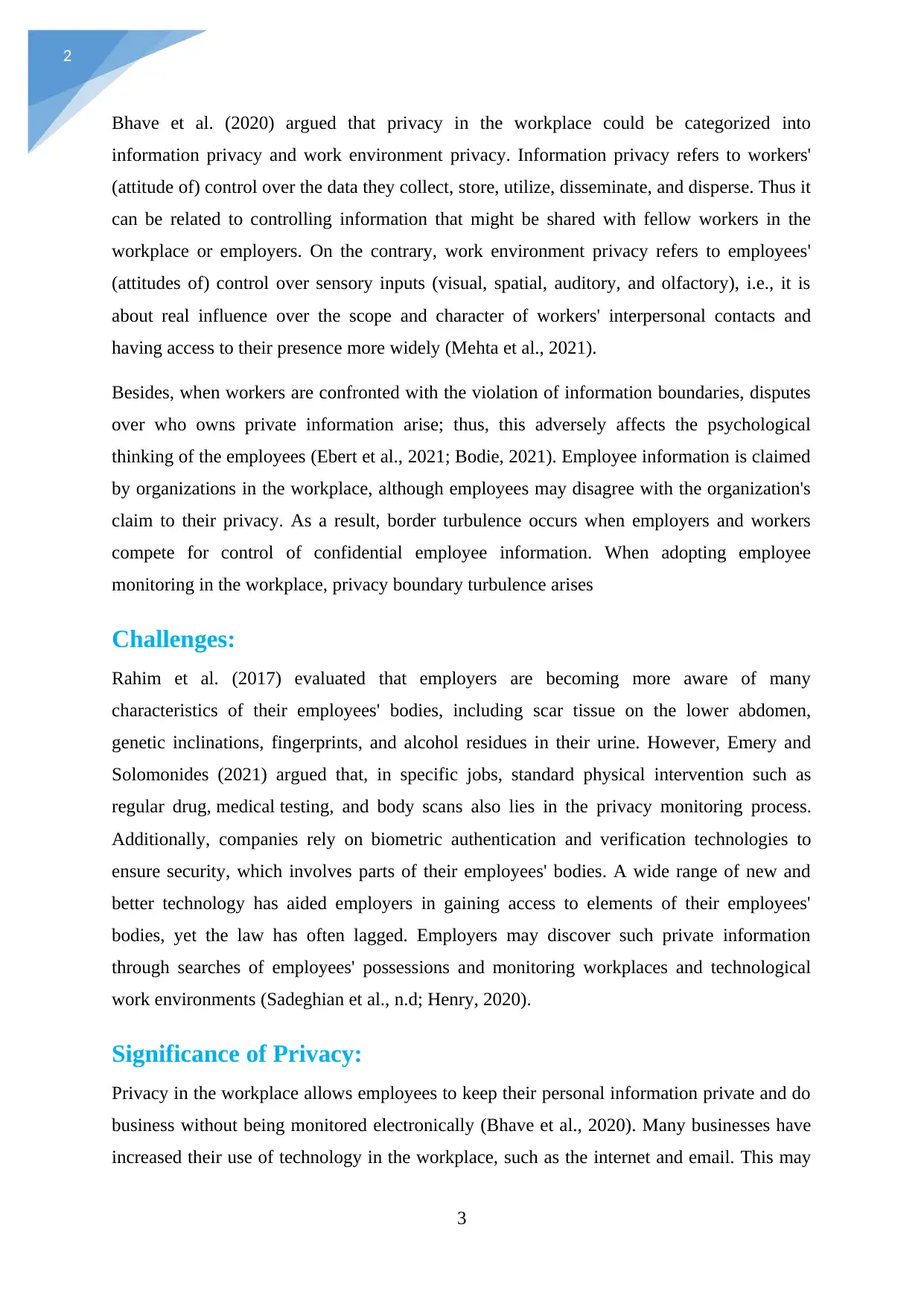
2
Bhave et al. (2020) argued that privacy in the workplace could be categorized into
information privacy and work environment privacy. Information privacy refers to workers'
(attitude of) control over the data they collect, store, utilize, disseminate, and disperse. Thus it
can be related to controlling information that might be shared with fellow workers in the
workplace or employers. On the contrary, work environment privacy refers to employees'
(attitudes of) control over sensory inputs (visual, spatial, auditory, and olfactory), i.e., it is
about real influence over the scope and character of workers' interpersonal contacts and
having access to their presence more widely (Mehta et al., 2021).
Besides, when workers are confronted with the violation of information boundaries, disputes
over who owns private information arise; thus, this adversely affects the psychological
thinking of the employees (Ebert et al., 2021; Bodie, 2021). Employee information is claimed
by organizations in the workplace, although employees may disagree with the organization's
claim to their privacy. As a result, border turbulence occurs when employers and workers
compete for control of confidential employee information. When adopting employee
monitoring in the workplace, privacy boundary turbulence arises
Challenges:
Rahim et al. (2017) evaluated that employers are becoming more aware of many
characteristics of their employees' bodies, including scar tissue on the lower abdomen,
genetic inclinations, fingerprints, and alcohol residues in their urine. However, Emery and
Solomonides (2021) argued that, in specific jobs, standard physical intervention such as
regular drug, medical testing, and body scans also lies in the privacy monitoring process.
Additionally, companies rely on biometric authentication and verification technologies to
ensure security, which involves parts of their employees' bodies. A wide range of new and
better technology has aided employers in gaining access to elements of their employees'
bodies, yet the law has often lagged. Employers may discover such private information
through searches of employees' possessions and monitoring workplaces and technological
work environments (Sadeghian et al., n.d; Henry, 2020).
Significance of Privacy:
Privacy in the workplace allows employees to keep their personal information private and do
business without being monitored electronically (Bhave et al., 2020). Many businesses have
increased their use of technology in the workplace, such as the internet and email. This may
3
Bhave et al. (2020) argued that privacy in the workplace could be categorized into
information privacy and work environment privacy. Information privacy refers to workers'
(attitude of) control over the data they collect, store, utilize, disseminate, and disperse. Thus it
can be related to controlling information that might be shared with fellow workers in the
workplace or employers. On the contrary, work environment privacy refers to employees'
(attitudes of) control over sensory inputs (visual, spatial, auditory, and olfactory), i.e., it is
about real influence over the scope and character of workers' interpersonal contacts and
having access to their presence more widely (Mehta et al., 2021).
Besides, when workers are confronted with the violation of information boundaries, disputes
over who owns private information arise; thus, this adversely affects the psychological
thinking of the employees (Ebert et al., 2021; Bodie, 2021). Employee information is claimed
by organizations in the workplace, although employees may disagree with the organization's
claim to their privacy. As a result, border turbulence occurs when employers and workers
compete for control of confidential employee information. When adopting employee
monitoring in the workplace, privacy boundary turbulence arises
Challenges:
Rahim et al. (2017) evaluated that employers are becoming more aware of many
characteristics of their employees' bodies, including scar tissue on the lower abdomen,
genetic inclinations, fingerprints, and alcohol residues in their urine. However, Emery and
Solomonides (2021) argued that, in specific jobs, standard physical intervention such as
regular drug, medical testing, and body scans also lies in the privacy monitoring process.
Additionally, companies rely on biometric authentication and verification technologies to
ensure security, which involves parts of their employees' bodies. A wide range of new and
better technology has aided employers in gaining access to elements of their employees'
bodies, yet the law has often lagged. Employers may discover such private information
through searches of employees' possessions and monitoring workplaces and technological
work environments (Sadeghian et al., n.d; Henry, 2020).
Significance of Privacy:
Privacy in the workplace allows employees to keep their personal information private and do
business without being monitored electronically (Bhave et al., 2020). Many businesses have
increased their use of technology in the workplace, such as the internet and email. This may
3
⊘ This is a preview!⊘
Do you want full access?
Subscribe today to unlock all pages.

Trusted by 1+ million students worldwide
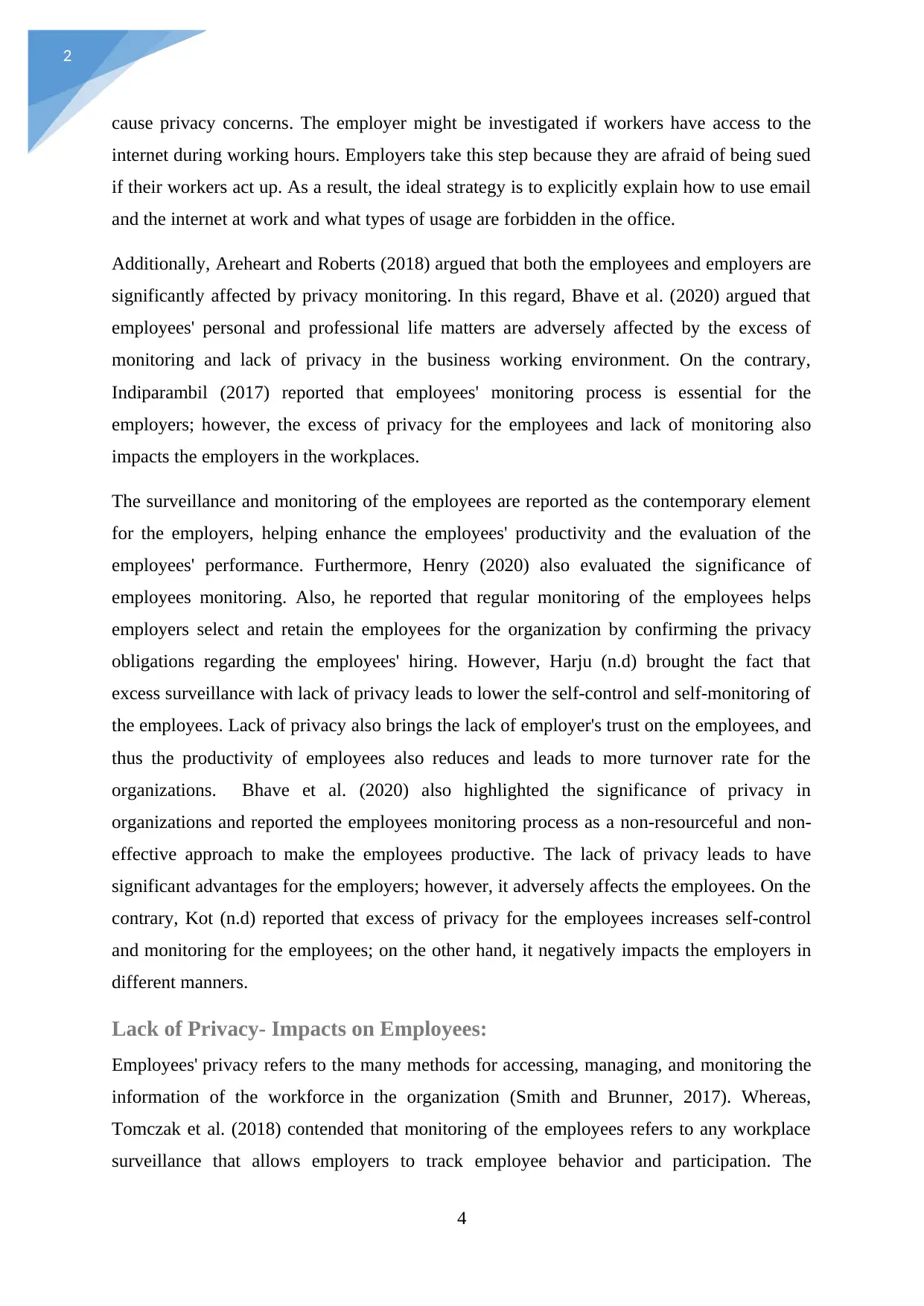
2
cause privacy concerns. The employer might be investigated if workers have access to the
internet during working hours. Employers take this step because they are afraid of being sued
if their workers act up. As a result, the ideal strategy is to explicitly explain how to use email
and the internet at work and what types of usage are forbidden in the office.
Additionally, Areheart and Roberts (2018) argued that both the employees and employers are
significantly affected by privacy monitoring. In this regard, Bhave et al. (2020) argued that
employees' personal and professional life matters are adversely affected by the excess of
monitoring and lack of privacy in the business working environment. On the contrary,
Indiparambil (2017) reported that employees' monitoring process is essential for the
employers; however, the excess of privacy for the employees and lack of monitoring also
impacts the employers in the workplaces.
The surveillance and monitoring of the employees are reported as the contemporary element
for the employers, helping enhance the employees' productivity and the evaluation of the
employees' performance. Furthermore, Henry (2020) also evaluated the significance of
employees monitoring. Also, he reported that regular monitoring of the employees helps
employers select and retain the employees for the organization by confirming the privacy
obligations regarding the employees' hiring. However, Harju (n.d) brought the fact that
excess surveillance with lack of privacy leads to lower the self-control and self-monitoring of
the employees. Lack of privacy also brings the lack of employer's trust on the employees, and
thus the productivity of employees also reduces and leads to more turnover rate for the
organizations. Bhave et al. (2020) also highlighted the significance of privacy in
organizations and reported the employees monitoring process as a non-resourceful and non-
effective approach to make the employees productive. The lack of privacy leads to have
significant advantages for the employers; however, it adversely affects the employees. On the
contrary, Kot (n.d) reported that excess of privacy for the employees increases self-control
and monitoring for the employees; on the other hand, it negatively impacts the employers in
different manners.
Lack of Privacy- Impacts on Employees:
Employees' privacy refers to the many methods for accessing, managing, and monitoring the
information of the workforce in the organization (Smith and Brunner, 2017). Whereas,
Tomczak et al. (2018) contended that monitoring of the employees refers to any workplace
surveillance that allows employers to track employee behavior and participation. The
4
cause privacy concerns. The employer might be investigated if workers have access to the
internet during working hours. Employers take this step because they are afraid of being sued
if their workers act up. As a result, the ideal strategy is to explicitly explain how to use email
and the internet at work and what types of usage are forbidden in the office.
Additionally, Areheart and Roberts (2018) argued that both the employees and employers are
significantly affected by privacy monitoring. In this regard, Bhave et al. (2020) argued that
employees' personal and professional life matters are adversely affected by the excess of
monitoring and lack of privacy in the business working environment. On the contrary,
Indiparambil (2017) reported that employees' monitoring process is essential for the
employers; however, the excess of privacy for the employees and lack of monitoring also
impacts the employers in the workplaces.
The surveillance and monitoring of the employees are reported as the contemporary element
for the employers, helping enhance the employees' productivity and the evaluation of the
employees' performance. Furthermore, Henry (2020) also evaluated the significance of
employees monitoring. Also, he reported that regular monitoring of the employees helps
employers select and retain the employees for the organization by confirming the privacy
obligations regarding the employees' hiring. However, Harju (n.d) brought the fact that
excess surveillance with lack of privacy leads to lower the self-control and self-monitoring of
the employees. Lack of privacy also brings the lack of employer's trust on the employees, and
thus the productivity of employees also reduces and leads to more turnover rate for the
organizations. Bhave et al. (2020) also highlighted the significance of privacy in
organizations and reported the employees monitoring process as a non-resourceful and non-
effective approach to make the employees productive. The lack of privacy leads to have
significant advantages for the employers; however, it adversely affects the employees. On the
contrary, Kot (n.d) reported that excess of privacy for the employees increases self-control
and monitoring for the employees; on the other hand, it negatively impacts the employers in
different manners.
Lack of Privacy- Impacts on Employees:
Employees' privacy refers to the many methods for accessing, managing, and monitoring the
information of the workforce in the organization (Smith and Brunner, 2017). Whereas,
Tomczak et al. (2018) contended that monitoring of the employees refers to any workplace
surveillance that allows employers to track employee behavior and participation. The
4
Paraphrase This Document
Need a fresh take? Get an instant paraphrase of this document with our AI Paraphraser
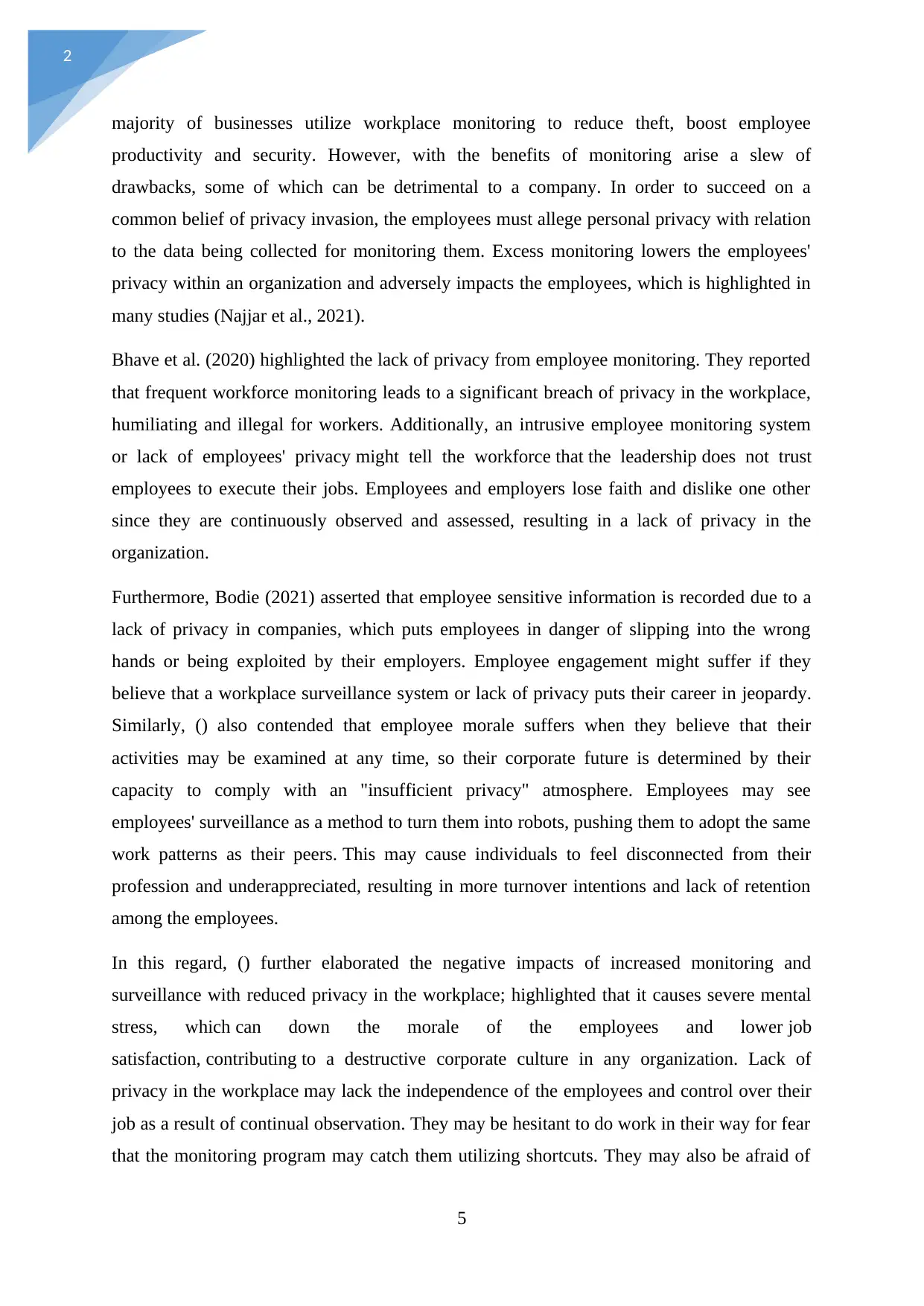
2
majority of businesses utilize workplace monitoring to reduce theft, boost employee
productivity and security. However, with the benefits of monitoring arise a slew of
drawbacks, some of which can be detrimental to a company. In order to succeed on a
common belief of privacy invasion, the employees must allege personal privacy with relation
to the data being collected for monitoring them. Excess monitoring lowers the employees'
privacy within an organization and adversely impacts the employees, which is highlighted in
many studies (Najjar et al., 2021).
Bhave et al. (2020) highlighted the lack of privacy from employee monitoring. They reported
that frequent workforce monitoring leads to a significant breach of privacy in the workplace,
humiliating and illegal for workers. Additionally, an intrusive employee monitoring system
or lack of employees' privacy might tell the workforce that the leadership does not trust
employees to execute their jobs. Employees and employers lose faith and dislike one other
since they are continuously observed and assessed, resulting in a lack of privacy in the
organization.
Furthermore, Bodie (2021) asserted that employee sensitive information is recorded due to a
lack of privacy in companies, which puts employees in danger of slipping into the wrong
hands or being exploited by their employers. Employee engagement might suffer if they
believe that a workplace surveillance system or lack of privacy puts their career in jeopardy.
Similarly, () also contended that employee morale suffers when they believe that their
activities may be examined at any time, so their corporate future is determined by their
capacity to comply with an "insufficient privacy" atmosphere. Employees may see
employees' surveillance as a method to turn them into robots, pushing them to adopt the same
work patterns as their peers. This may cause individuals to feel disconnected from their
profession and underappreciated, resulting in more turnover intentions and lack of retention
among the employees.
In this regard, () further elaborated the negative impacts of increased monitoring and
surveillance with reduced privacy in the workplace; highlighted that it causes severe mental
stress, which can down the morale of the employees and lower job
satisfaction, contributing to a destructive corporate culture in any organization. Lack of
privacy in the workplace may lack the independence of the employees and control over their
job as a result of continual observation. They may be hesitant to do work in their way for fear
that the monitoring program may catch them utilizing shortcuts. They may also be afraid of
5
majority of businesses utilize workplace monitoring to reduce theft, boost employee
productivity and security. However, with the benefits of monitoring arise a slew of
drawbacks, some of which can be detrimental to a company. In order to succeed on a
common belief of privacy invasion, the employees must allege personal privacy with relation
to the data being collected for monitoring them. Excess monitoring lowers the employees'
privacy within an organization and adversely impacts the employees, which is highlighted in
many studies (Najjar et al., 2021).
Bhave et al. (2020) highlighted the lack of privacy from employee monitoring. They reported
that frequent workforce monitoring leads to a significant breach of privacy in the workplace,
humiliating and illegal for workers. Additionally, an intrusive employee monitoring system
or lack of employees' privacy might tell the workforce that the leadership does not trust
employees to execute their jobs. Employees and employers lose faith and dislike one other
since they are continuously observed and assessed, resulting in a lack of privacy in the
organization.
Furthermore, Bodie (2021) asserted that employee sensitive information is recorded due to a
lack of privacy in companies, which puts employees in danger of slipping into the wrong
hands or being exploited by their employers. Employee engagement might suffer if they
believe that a workplace surveillance system or lack of privacy puts their career in jeopardy.
Similarly, () also contended that employee morale suffers when they believe that their
activities may be examined at any time, so their corporate future is determined by their
capacity to comply with an "insufficient privacy" atmosphere. Employees may see
employees' surveillance as a method to turn them into robots, pushing them to adopt the same
work patterns as their peers. This may cause individuals to feel disconnected from their
profession and underappreciated, resulting in more turnover intentions and lack of retention
among the employees.
In this regard, () further elaborated the negative impacts of increased monitoring and
surveillance with reduced privacy in the workplace; highlighted that it causes severe mental
stress, which can down the morale of the employees and lower job
satisfaction, contributing to a destructive corporate culture in any organization. Lack of
privacy in the workplace may lack the independence of the employees and control over their
job as a result of continual observation. They may be hesitant to do work in their way for fear
that the monitoring program may catch them utilizing shortcuts. They may also be afraid of
5
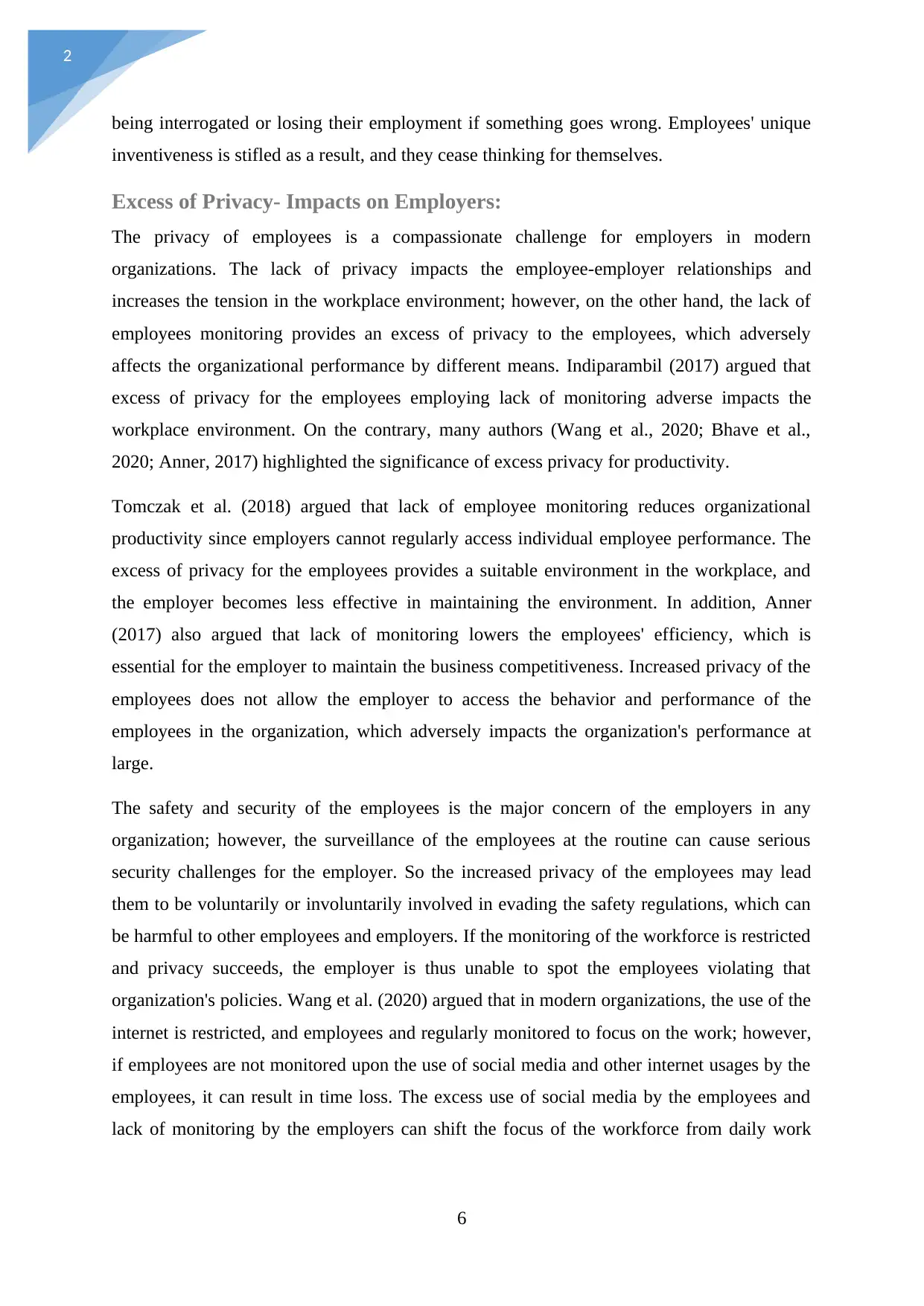
2
being interrogated or losing their employment if something goes wrong. Employees' unique
inventiveness is stifled as a result, and they cease thinking for themselves.
Excess of Privacy- Impacts on Employers:
The privacy of employees is a compassionate challenge for employers in modern
organizations. The lack of privacy impacts the employee-employer relationships and
increases the tension in the workplace environment; however, on the other hand, the lack of
employees monitoring provides an excess of privacy to the employees, which adversely
affects the organizational performance by different means. Indiparambil (2017) argued that
excess of privacy for the employees employing lack of monitoring adverse impacts the
workplace environment. On the contrary, many authors (Wang et al., 2020; Bhave et al.,
2020; Anner, 2017) highlighted the significance of excess privacy for productivity.
Tomczak et al. (2018) argued that lack of employee monitoring reduces organizational
productivity since employers cannot regularly access individual employee performance. The
excess of privacy for the employees provides a suitable environment in the workplace, and
the employer becomes less effective in maintaining the environment. In addition, Anner
(2017) also argued that lack of monitoring lowers the employees' efficiency, which is
essential for the employer to maintain the business competitiveness. Increased privacy of the
employees does not allow the employer to access the behavior and performance of the
employees in the organization, which adversely impacts the organization's performance at
large.
The safety and security of the employees is the major concern of the employers in any
organization; however, the surveillance of the employees at the routine can cause serious
security challenges for the employer. So the increased privacy of the employees may lead
them to be voluntarily or involuntarily involved in evading the safety regulations, which can
be harmful to other employees and employers. If the monitoring of the workforce is restricted
and privacy succeeds, the employer is thus unable to spot the employees violating that
organization's policies. Wang et al. (2020) argued that in modern organizations, the use of the
internet is restricted, and employees and regularly monitored to focus on the work; however,
if employees are not monitored upon the use of social media and other internet usages by the
employees, it can result in time loss. The excess use of social media by the employees and
lack of monitoring by the employers can shift the focus of the workforce from daily work
6
being interrogated or losing their employment if something goes wrong. Employees' unique
inventiveness is stifled as a result, and they cease thinking for themselves.
Excess of Privacy- Impacts on Employers:
The privacy of employees is a compassionate challenge for employers in modern
organizations. The lack of privacy impacts the employee-employer relationships and
increases the tension in the workplace environment; however, on the other hand, the lack of
employees monitoring provides an excess of privacy to the employees, which adversely
affects the organizational performance by different means. Indiparambil (2017) argued that
excess of privacy for the employees employing lack of monitoring adverse impacts the
workplace environment. On the contrary, many authors (Wang et al., 2020; Bhave et al.,
2020; Anner, 2017) highlighted the significance of excess privacy for productivity.
Tomczak et al. (2018) argued that lack of employee monitoring reduces organizational
productivity since employers cannot regularly access individual employee performance. The
excess of privacy for the employees provides a suitable environment in the workplace, and
the employer becomes less effective in maintaining the environment. In addition, Anner
(2017) also argued that lack of monitoring lowers the employees' efficiency, which is
essential for the employer to maintain the business competitiveness. Increased privacy of the
employees does not allow the employer to access the behavior and performance of the
employees in the organization, which adversely impacts the organization's performance at
large.
The safety and security of the employees is the major concern of the employers in any
organization; however, the surveillance of the employees at the routine can cause serious
security challenges for the employer. So the increased privacy of the employees may lead
them to be voluntarily or involuntarily involved in evading the safety regulations, which can
be harmful to other employees and employers. If the monitoring of the workforce is restricted
and privacy succeeds, the employer is thus unable to spot the employees violating that
organization's policies. Wang et al. (2020) argued that in modern organizations, the use of the
internet is restricted, and employees and regularly monitored to focus on the work; however,
if employees are not monitored upon the use of social media and other internet usages by the
employees, it can result in time loss. The excess use of social media by the employees and
lack of monitoring by the employers can shift the focus of the workforce from daily work
6
⊘ This is a preview!⊘
Do you want full access?
Subscribe today to unlock all pages.

Trusted by 1+ million students worldwide
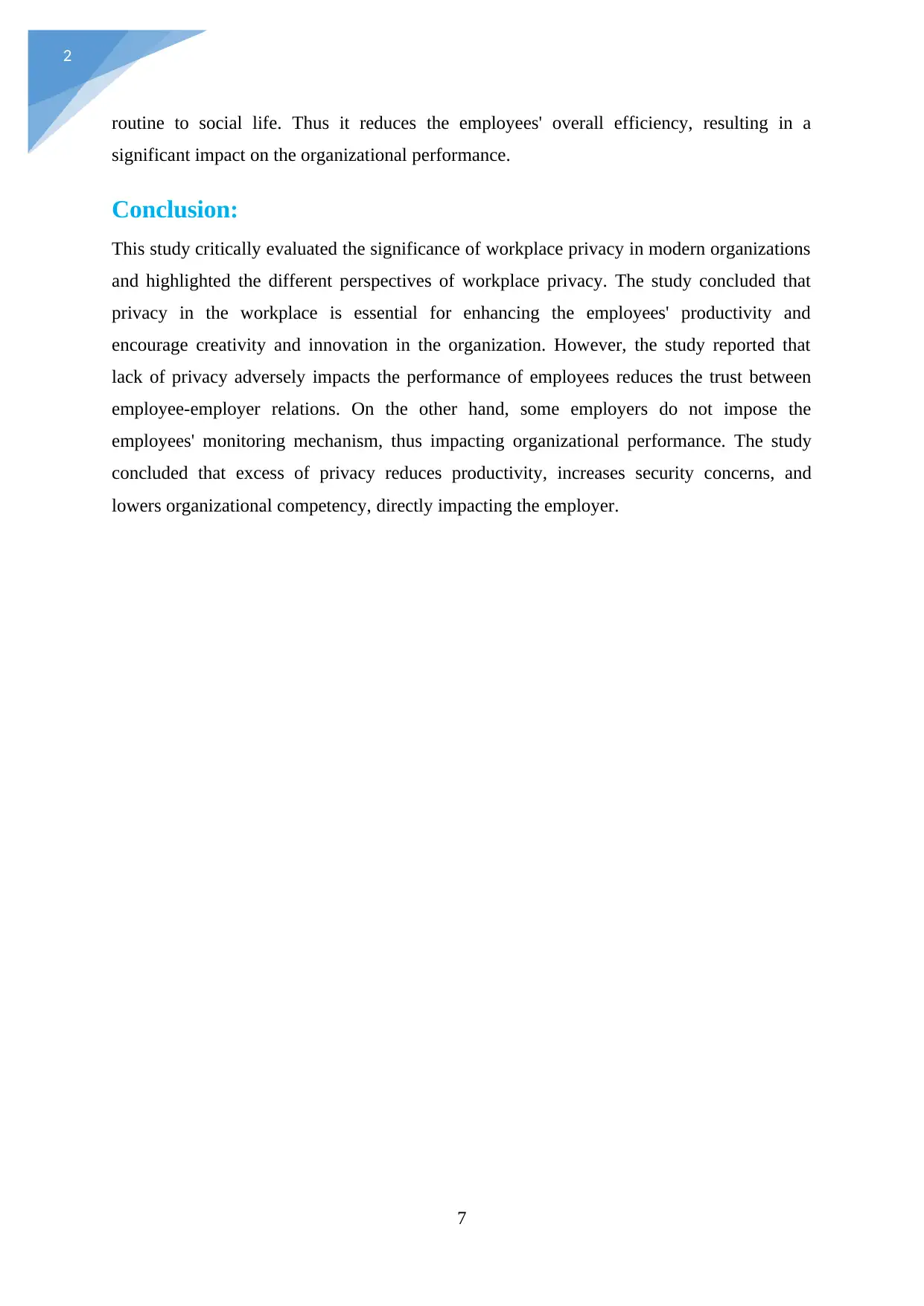
2
routine to social life. Thus it reduces the employees' overall efficiency, resulting in a
significant impact on the organizational performance.
Conclusion:
This study critically evaluated the significance of workplace privacy in modern organizations
and highlighted the different perspectives of workplace privacy. The study concluded that
privacy in the workplace is essential for enhancing the employees' productivity and
encourage creativity and innovation in the organization. However, the study reported that
lack of privacy adversely impacts the performance of employees reduces the trust between
employee-employer relations. On the other hand, some employers do not impose the
employees' monitoring mechanism, thus impacting organizational performance. The study
concluded that excess of privacy reduces productivity, increases security concerns, and
lowers organizational competency, directly impacting the employer.
7
routine to social life. Thus it reduces the employees' overall efficiency, resulting in a
significant impact on the organizational performance.
Conclusion:
This study critically evaluated the significance of workplace privacy in modern organizations
and highlighted the different perspectives of workplace privacy. The study concluded that
privacy in the workplace is essential for enhancing the employees' productivity and
encourage creativity and innovation in the organization. However, the study reported that
lack of privacy adversely impacts the performance of employees reduces the trust between
employee-employer relations. On the other hand, some employers do not impose the
employees' monitoring mechanism, thus impacting organizational performance. The study
concluded that excess of privacy reduces productivity, increases security concerns, and
lowers organizational competency, directly impacting the employer.
7
Paraphrase This Document
Need a fresh take? Get an instant paraphrase of this document with our AI Paraphraser
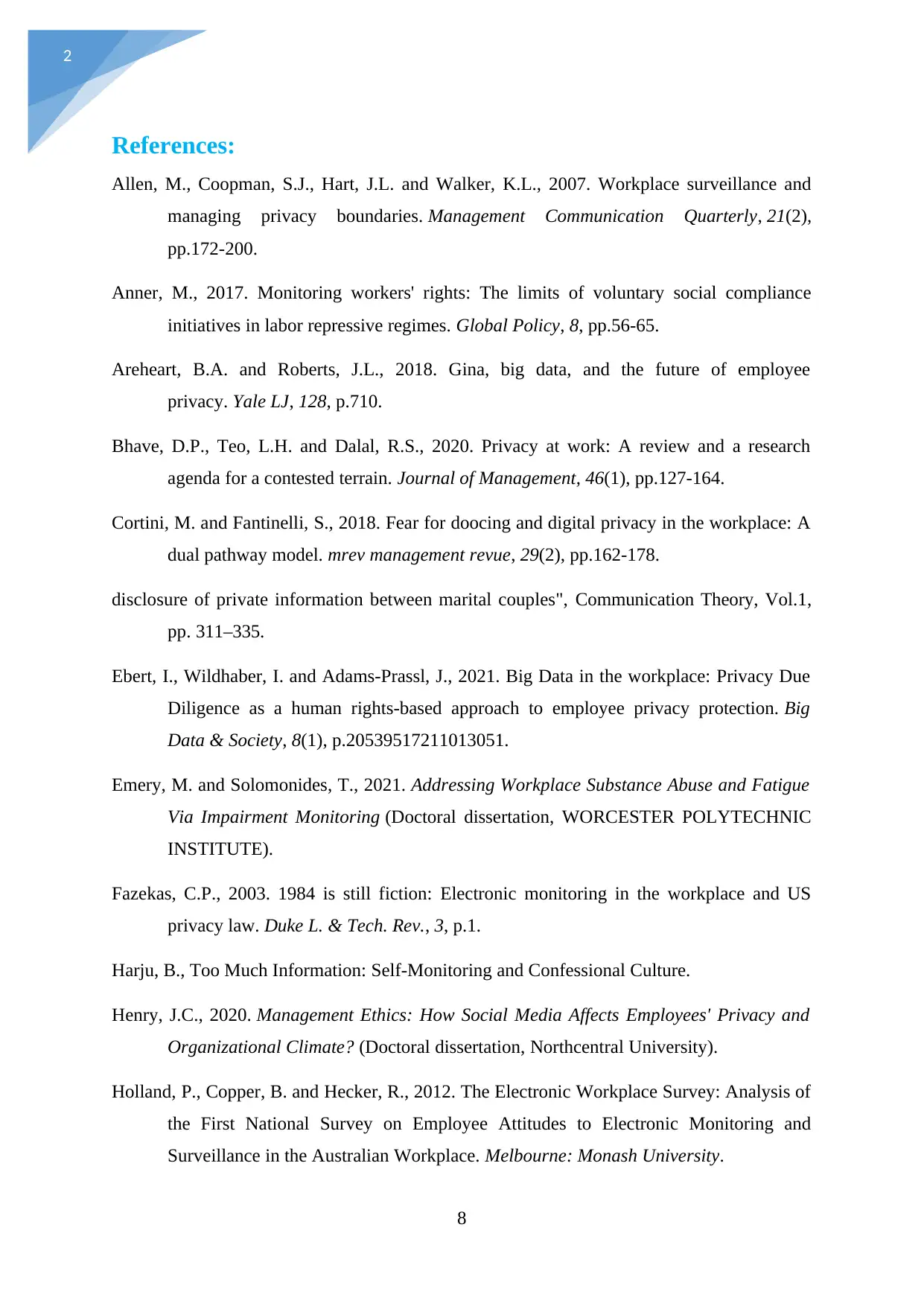
2
References:
Allen, M., Coopman, S.J., Hart, J.L. and Walker, K.L., 2007. Workplace surveillance and
managing privacy boundaries. Management Communication Quarterly, 21(2),
pp.172-200.
Anner, M., 2017. Monitoring workers' rights: The limits of voluntary social compliance
initiatives in labor repressive regimes. Global Policy, 8, pp.56-65.
Areheart, B.A. and Roberts, J.L., 2018. Gina, big data, and the future of employee
privacy. Yale LJ, 128, p.710.
Bhave, D.P., Teo, L.H. and Dalal, R.S., 2020. Privacy at work: A review and a research
agenda for a contested terrain. Journal of Management, 46(1), pp.127-164.
Cortini, M. and Fantinelli, S., 2018. Fear for doocing and digital privacy in the workplace: A
dual pathway model. mrev management revue, 29(2), pp.162-178.
disclosure of private information between marital couples", Communication Theory, Vol.1,
pp. 311–335.
Ebert, I., Wildhaber, I. and Adams-Prassl, J., 2021. Big Data in the workplace: Privacy Due
Diligence as a human rights-based approach to employee privacy protection. Big
Data & Society, 8(1), p.20539517211013051.
Emery, M. and Solomonides, T., 2021. Addressing Workplace Substance Abuse and Fatigue
Via Impairment Monitoring (Doctoral dissertation, WORCESTER POLYTECHNIC
INSTITUTE).
Fazekas, C.P., 2003. 1984 is still fiction: Electronic monitoring in the workplace and US
privacy law. Duke L. & Tech. Rev., 3, p.1.
Harju, B., Too Much Information: Self-Monitoring and Confessional Culture.
Henry, J.C., 2020. Management Ethics: How Social Media Affects Employees' Privacy and
Organizational Climate? (Doctoral dissertation, Northcentral University).
Holland, P., Copper, B. and Hecker, R., 2012. The Electronic Workplace Survey: Analysis of
the First National Survey on Employee Attitudes to Electronic Monitoring and
Surveillance in the Australian Workplace. Melbourne: Monash University.
8
References:
Allen, M., Coopman, S.J., Hart, J.L. and Walker, K.L., 2007. Workplace surveillance and
managing privacy boundaries. Management Communication Quarterly, 21(2),
pp.172-200.
Anner, M., 2017. Monitoring workers' rights: The limits of voluntary social compliance
initiatives in labor repressive regimes. Global Policy, 8, pp.56-65.
Areheart, B.A. and Roberts, J.L., 2018. Gina, big data, and the future of employee
privacy. Yale LJ, 128, p.710.
Bhave, D.P., Teo, L.H. and Dalal, R.S., 2020. Privacy at work: A review and a research
agenda for a contested terrain. Journal of Management, 46(1), pp.127-164.
Cortini, M. and Fantinelli, S., 2018. Fear for doocing and digital privacy in the workplace: A
dual pathway model. mrev management revue, 29(2), pp.162-178.
disclosure of private information between marital couples", Communication Theory, Vol.1,
pp. 311–335.
Ebert, I., Wildhaber, I. and Adams-Prassl, J., 2021. Big Data in the workplace: Privacy Due
Diligence as a human rights-based approach to employee privacy protection. Big
Data & Society, 8(1), p.20539517211013051.
Emery, M. and Solomonides, T., 2021. Addressing Workplace Substance Abuse and Fatigue
Via Impairment Monitoring (Doctoral dissertation, WORCESTER POLYTECHNIC
INSTITUTE).
Fazekas, C.P., 2003. 1984 is still fiction: Electronic monitoring in the workplace and US
privacy law. Duke L. & Tech. Rev., 3, p.1.
Harju, B., Too Much Information: Self-Monitoring and Confessional Culture.
Henry, J.C., 2020. Management Ethics: How Social Media Affects Employees' Privacy and
Organizational Climate? (Doctoral dissertation, Northcentral University).
Holland, P., Copper, B. and Hecker, R., 2012. The Electronic Workplace Survey: Analysis of
the First National Survey on Employee Attitudes to Electronic Monitoring and
Surveillance in the Australian Workplace. Melbourne: Monash University.
8
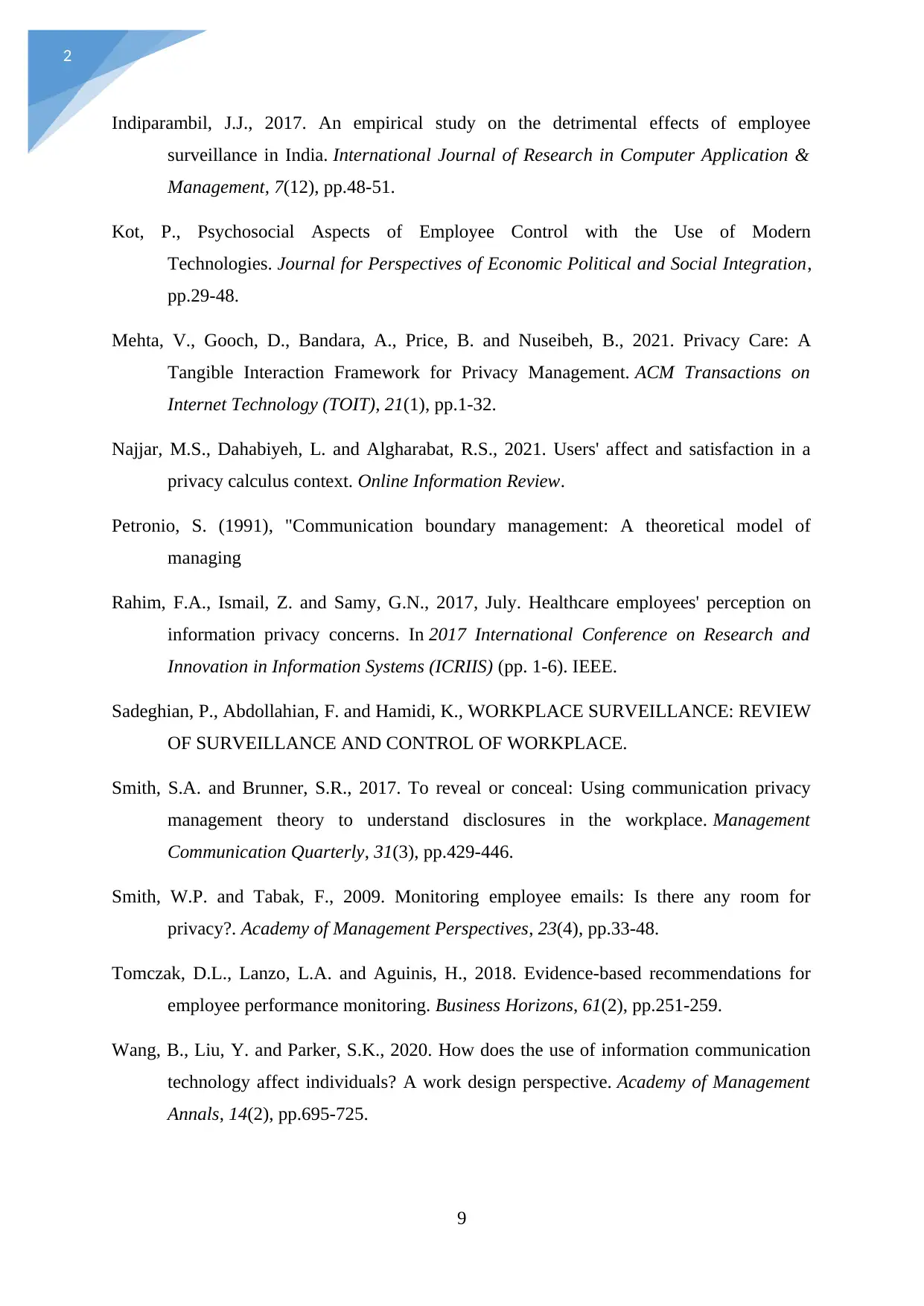
2
Indiparambil, J.J., 2017. An empirical study on the detrimental effects of employee
surveillance in India. International Journal of Research in Computer Application &
Management, 7(12), pp.48-51.
Kot, P., Psychosocial Aspects of Employee Control with the Use of Modern
Technologies. Journal for Perspectives of Economic Political and Social Integration,
pp.29-48.
Mehta, V., Gooch, D., Bandara, A., Price, B. and Nuseibeh, B., 2021. Privacy Care: A
Tangible Interaction Framework for Privacy Management. ACM Transactions on
Internet Technology (TOIT), 21(1), pp.1-32.
Najjar, M.S., Dahabiyeh, L. and Algharabat, R.S., 2021. Users' affect and satisfaction in a
privacy calculus context. Online Information Review.
Petronio, S. (1991), "Communication boundary management: A theoretical model of
managing
Rahim, F.A., Ismail, Z. and Samy, G.N., 2017, July. Healthcare employees' perception on
information privacy concerns. In 2017 International Conference on Research and
Innovation in Information Systems (ICRIIS) (pp. 1-6). IEEE.
Sadeghian, P., Abdollahian, F. and Hamidi, K., WORKPLACE SURVEILLANCE: REVIEW
OF SURVEILLANCE AND CONTROL OF WORKPLACE.
Smith, S.A. and Brunner, S.R., 2017. To reveal or conceal: Using communication privacy
management theory to understand disclosures in the workplace. Management
Communication Quarterly, 31(3), pp.429-446.
Smith, W.P. and Tabak, F., 2009. Monitoring employee emails: Is there any room for
privacy?. Academy of Management Perspectives, 23(4), pp.33-48.
Tomczak, D.L., Lanzo, L.A. and Aguinis, H., 2018. Evidence-based recommendations for
employee performance monitoring. Business Horizons, 61(2), pp.251-259.
Wang, B., Liu, Y. and Parker, S.K., 2020. How does the use of information communication
technology affect individuals? A work design perspective. Academy of Management
Annals, 14(2), pp.695-725.
9
Indiparambil, J.J., 2017. An empirical study on the detrimental effects of employee
surveillance in India. International Journal of Research in Computer Application &
Management, 7(12), pp.48-51.
Kot, P., Psychosocial Aspects of Employee Control with the Use of Modern
Technologies. Journal for Perspectives of Economic Political and Social Integration,
pp.29-48.
Mehta, V., Gooch, D., Bandara, A., Price, B. and Nuseibeh, B., 2021. Privacy Care: A
Tangible Interaction Framework for Privacy Management. ACM Transactions on
Internet Technology (TOIT), 21(1), pp.1-32.
Najjar, M.S., Dahabiyeh, L. and Algharabat, R.S., 2021. Users' affect and satisfaction in a
privacy calculus context. Online Information Review.
Petronio, S. (1991), "Communication boundary management: A theoretical model of
managing
Rahim, F.A., Ismail, Z. and Samy, G.N., 2017, July. Healthcare employees' perception on
information privacy concerns. In 2017 International Conference on Research and
Innovation in Information Systems (ICRIIS) (pp. 1-6). IEEE.
Sadeghian, P., Abdollahian, F. and Hamidi, K., WORKPLACE SURVEILLANCE: REVIEW
OF SURVEILLANCE AND CONTROL OF WORKPLACE.
Smith, S.A. and Brunner, S.R., 2017. To reveal or conceal: Using communication privacy
management theory to understand disclosures in the workplace. Management
Communication Quarterly, 31(3), pp.429-446.
Smith, W.P. and Tabak, F., 2009. Monitoring employee emails: Is there any room for
privacy?. Academy of Management Perspectives, 23(4), pp.33-48.
Tomczak, D.L., Lanzo, L.A. and Aguinis, H., 2018. Evidence-based recommendations for
employee performance monitoring. Business Horizons, 61(2), pp.251-259.
Wang, B., Liu, Y. and Parker, S.K., 2020. How does the use of information communication
technology affect individuals? A work design perspective. Academy of Management
Annals, 14(2), pp.695-725.
9
⊘ This is a preview!⊘
Do you want full access?
Subscribe today to unlock all pages.

Trusted by 1+ million students worldwide
1 out of 9
Related Documents
Your All-in-One AI-Powered Toolkit for Academic Success.
+13062052269
info@desklib.com
Available 24*7 on WhatsApp / Email
![[object Object]](/_next/static/media/star-bottom.7253800d.svg)
Unlock your academic potential
Copyright © 2020–2025 A2Z Services. All Rights Reserved. Developed and managed by ZUCOL.




